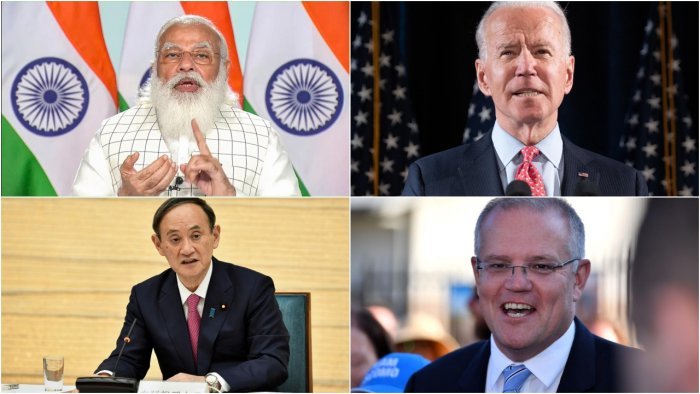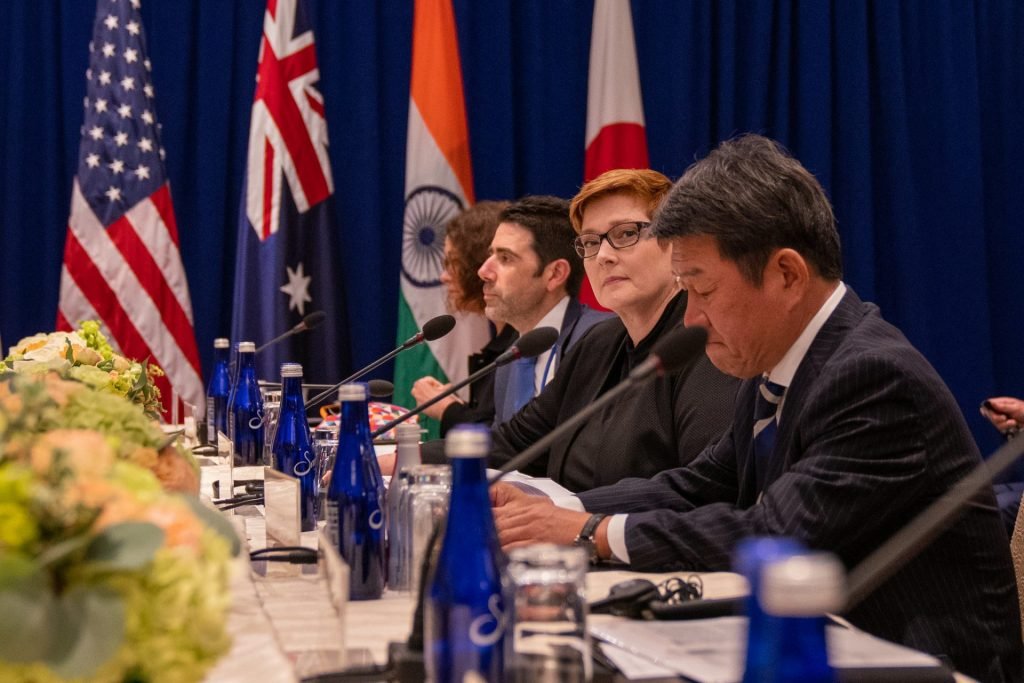Asian NATO: The Emergence of QUAD

The sleeping dragon has awoken after being relegated to the geopolitical sidelines for much of the previous two centuries. China has begun to reassert its place which China perceives is the center of global affairs. Market reforms and integration into the global economy have given Beijing significant coercive power, which has been followed in recent year by the development of military muscle. Understandably these developments have stirred anxieties across the Asia-Pacific resulting in concerned nations forming a pact to contain China. Dubbed as the Asian NATO the newly revived quadrilateral security dialogue or QUAD consists of Australia, India, Japan and the United States. Banded together by a shared set of interests, the QUAD is fast becoming the leading body for Asia-Pacific security.
The 2004 boxing day tsunami was a catastrophe of a kind rarely seen in modern times. An earthquake measuring 9.2 in magnitude occurred in North West Sumatra bringing a 30-meter wave that devastated coastlines across the Indian Ocean. Within hours nearly 230000 people across 14 different countries lost their lives. As aid began to pour in from across the globe Australia, India, Japan and United State took the lead in coordination relief efforts. Over the next nine days, this coalition helped contribute over 40000 troops and humanitarian workers as well as dozens of helicopters, ships and transport planes. It was an inspiring multinational effort and a welcome departure from the cynical calculus that offer dominates international affairs. The mission ended in January 2005 when the UN assumed responsibility.
The success of the coalition generated excitement within diplomatic circles over the potential for a permanent institutional body. The idea was championed by former Japanese prime minister Shinzo Abe who wanted to tempt India into the American-led security umbrella that included Australia. By doing so Abe believed that India would counterbalance China and help promote the cause of democracy in Asia. New Delhi recognizing an opportunity to secure Washington’s support for its nuclear program accepted the offer and in early 2007 quadrilateral security dialogue was formed in Manila. Over the next few months lines of communications were opened and the four nations conducted joint naval exercises in the Bay of Bengal.

However, the anti-China purpose of QUAD was evident from the start and before long Beijing was making complaints to the bloc’s individual members. This diplomatic pressure began to cause rifts within the group. As it turned out neither Canberra, New Delhi nor Tokyo was willing to sacrifice their relationship with Beijing. When forced to make a choice, bilateral relations with Beijing trumped each state’s obligations to one another. Australia’s exit from the group in early 2008, merely confirmed what was already known. A year later the QUAD faded into obscurity. Nevertheless, political ideas have a shelf life that extends well beyond their original historical context. In recent times increased tensions in the Asia-Pacific on account of expansionist action undertaken by Beijing have reinforced the need for an alliance structure to maintain the balance of power in the region. At the forefront of the efforts to revive QUAD is the United State, which is locking to complete its pivot towards Asia. With three of Asia’s most prominent states as members, much of the commentary surrounding QUAD has focused on its ability to stifle China’s attempts to achieve Asian hegemony.
However American strategy will be constrained by two crucial factors. First, Chinese military power and in particular its missile umbrella is unchallenged between the Himalayas and the sea of Japan. There are multiple layers in China’s defense. The closer one gets to the Chinese mainland, the stronger China’s anti-access area denial capabilities become. Foreign power projection is nearly unbearable in the inner circle. This effectively rules out direct military intervention. Second, while in the past Washington used economic warfare to coerce its enemies. China is far too integrated into the global economy to be isolated. Most countries trade more with China than they do with the United States.
In other words attempting to contain China by development of traditional measures such as economics sanctions and military interventions won’t do. Instead like the cold war America’s grand strategy in Asia will likely have to be one of containment necessitating a NATO-like alliance. Given the geography of east Asia this will take the form of sea denial. A strategy whereby hostile naval forces are prevented from gaining control of nearby sea lines of communications. As such joint exercises between the four navies have recently been renewed and should QUAD’s navies become fully interoperable. They could act to coerce China by threatening vital shipping lanes.

Furthermore, in addition to the unmatched sea power of the United States navy, QUAD’s member states each have territorial assets located at strategic checkpoints in Southeast Asia and along the first island chain which runs from the island of Borneo along with the Philippines to the coast of Japan. In the west, the Andaman and Nicobar islands provide India with a launchpad to project naval power into the strait of Malacca. Additionally, the Australian territory of Cocos island may prove valuable in plugging the alternatives trade routes that run through the Sunda Strait and the Lombok Strait. The territories airstrip is currently being upgraded to accommodate maritime patrol aircraft and the further development of the facility could lead to increased power projection capabilities.
In the east, the United States will take to cooperate with Japan using its facilities in Okinawa and its informal alliance with Taiwan to project power across the East China sea. However, this in itself will not be sufficient to control the oceans. A maritime denial strategy would seek to contain the Chinese navy by keeping it occupied in its backyard. However, since permanent fortifications are not possible in deep waters. China’s regional sea power will continue to be continually probed by geopolitical rivals.
Policymakers say that policymaking is never that easy and if the first integration of QUAD is anything to go by, the divergent interests of the four nations may prove to be a sticking point.
In India, it’s unclear whether New Delhi’s interests east of the Malacca strait are sufficient to bind it to a permanent alliance. While territorial disputes in the Himalayas have driven New Delhi to confront Beijing. India’s primarily foe is Pakistan, not China. Moreover, in terms of trade, India is generally more oriented towards the west than the east. While India trades considerably with East Asia, this accounts for less than half its trade value with Europe and the Middle East. So New Delhi has its reasons not to risk a confrontation with its most powerful neighbour.
Japan for its part is perhaps the most committed of the QUAD members to Chinese containment. This is due both to its geographic proximity and its high degree of integration into the United States alliance system. However, although Japan has disputes with China over the Senkaku islands and attempts at historical revisionism. Tokyo’s rhetoric towards its western neighbour has been more muted in recent times. Once more the concern is maintaining economic ties. Tokyo’s most play a delicate balancing act between security and prosperity and thus will not want to rock the boat so easily.

Even if these concerns are somehow addressed and QUAD develops into a stubble alliance. It will still have to strengthen its ties to Southeast Asia and nations in the first island chain to close the gaps in its sea denial strategy. That means gathering Vietnam, Singapore, Malesia, Indonesia, and the Philippines into a second-tier Alliance. This will require soft power influence that goes beyond merely containing China.
A commitment to upholding a rules-based order of international law and democratic values may look good on paper but unless these ideas are matched by tangible results on the ground. They are unlikely to win new friends. While some countries like Vietnam have remained firmly opposed to creeping Chinese influence. Beijing has been able to win over Cambodia and Laos through foreign direct investment, economic aid, and military hardware provision. Moreover, India has excluded itself from signing the regional comprehensive economic partnership a free trade deal that could set the rules of the Asian economic ecosystem in the years ahead. Without an economic counterweight to China in this platform, the relative importance of Chinese trade may cause more Asian countries to enter Beijing’s orbit over time.
Still in spite of the challenges the current situations in south-east Asia present QUAD with two clear opportunities to score diplomatic points. The first is COVID vaccination at the virtual summit in March 2021 QUAD pledged to provide southeast Asia with 1 Billion COVID vaccine doses by the end of 2022. If successful this COVID help QUAD establish genuine soft power influence in China’s backyard. Something that Beijing has thus far failed to achieve. Secondly, Tokyo and New Delhi over uniquely well-positioned to address the current political crisis in Myanmar where the military ceased power from the civilian government. Even after the west pulled investment out of Myanmar in response to the Rohingya prosecution Japan continues to invest in the country and provide economic aid. Using this leverage Tokyo brokered a ceasefire between the military and rebel groups in 2019. Additionally, New Delhi through its Act East Policy has established deep connections with the Burmese military. Through these activities, Tokyo and New Delhi may be able to negotiate a peaceful resolution through backroom channels. So certain programs such as the COVID vaccinations and the crisis in Myanmar provide opportunities to assert geopolitical designs.
In summary the advent of China will draw the power of Asia into a balancing coalition which will be constrained by strategic factors to pursue a policy of containment. QUAD while not currently a military alliance may from the basis of a containment block that performs a role like that of NATO during the cold war. However as demonstrated by the failure of the first QUAD. An alliance rooted in pure self-interest may not hold together. Through its inspiring actions in the wake of the 2004 Tsunami QUAD demonstrated its legitimacy. A robust soft power policy is essential otherwise the current QUAD will suffer the faith as the first that of four partners sleeping in the same bed but dreaming different dreams.


















